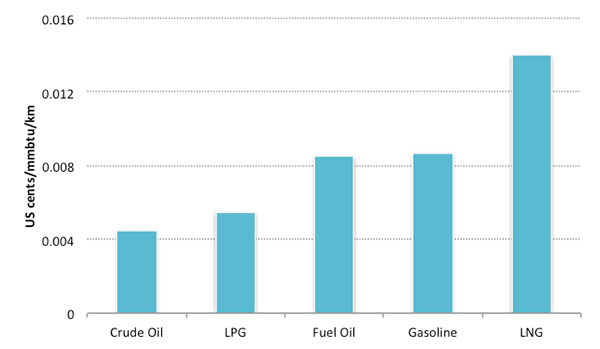Blog
Here’s one way to waste a lot less of our newfound natural gas resources
Geopolitics have rekindled an American domestic debate on exporting natural gas. Many believe that the United States should leverage its newfound wealth in natural gas to balance international demand and supply. Such a discussion was unthinkable even five years ago, when the conventional view was that the country would have to rely heavily upon imports to meet the growing demand for natural gas. This reversal of fortune has been catalyzed by new production technologies, which are profoundly changing the energy landscape. Many former energy importers with significant new gas reserves, such as Israel and Tanzania, are examining options to export natural gas. Two enormous markets, China and India, are increasingly counting on natural gas to wean their electricity sectors off coal.
A key link in the developing global natural gas supply chain will be the ships required to carry this commodity between suppliers and consumers on different continents, known as liquified natural gas (LNG) carriers. Given the extent of the changes in the energy industry over the past half-decade, it’s perhaps not surprising that LNG carriers have received comparatively little attention. But the price tag of continued inattention will be steep.
In contrast to crude oil tankers or containerships, whose operating costs only marginally affect the total cost of the goods they carry, LNG carriers represent more than 20% of total “door-to-door” trade costs, trailing only feedstock and liquefaction costs. On a cost per energy content per distance basis, transporting LNG by ship is three times as expensive as moving crude oil and two-and-a-half times as expensive as transporting liquefied petroleum gas (LPG) (Figure 1). About 40% of LNG transportation costs are fuel related. There are at present fewer than 350 LNG carriers operating worldwide, each propelled by 20 to 50 megawatt (MW) engines. These giant ships consumed 460 billion cubic feet (Bcf) of natural gas in 2011, equivalent to 80% of industrial natural gas demand in California that year. The natural gas consumption by LNG carriers will double by 2030, reaching 1000 Bcf, or about half of total natural gas demand in California in 2011.

Figure 1 Transportation costs by energy product
To better understand the energy consumption of LNG carriers, we estimated the operational efficiency of LNG carriers using global satellite Automatic Identification System data from 2011 and a methodology we developed (see here and here) to analyze technical and operational efficiency and carbon emissions across all international shipping. As is the case for other ship types, operational efficiency of LNG carriers varies widely. In fact, a 150% to 250% disparity in ship energy efficiency is common between leaders and laggards for LNG carriers. The top 5% most efficient LNG carriers are 37% more efficient than the industry average, while the 5% least efficient are 47% less efficient than the industry average. The efficiency gap can be explained by a slew of factors, such as how the ship is designed, the operational speed of the carrier, and the age of the vessel.
The Energy Efficiency Design Index, a mandatory efficiency target for new ships delivered after 2015, including LNG carriers, will shrink the gap, but not quickly. The average lifetime of an LNG carrier can be as long as 30 years, so the affect of introducing more efficient new vessels will be seen only gradually. Proposals under discussion at the International Maritime Organization to promote the efficiency of the in-use fleet have the potential for larger and more rapid impacts. Indeed, if LNG carriers would on average reach operational efficiency levels achieved by the top 5% LNG carriers in 2011 by 2030, total LNG carrier gas consumption would fall by 300 Bcf by 2040—enough gas to power half the gas-fired electricity generating plants in California in 2011. As efforts to expand natural gas production gain speed, people should think as well about the efficiency of LNG carriers.
